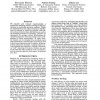Free Online Productivity Tools
i2Speak
i2Symbol
i2OCR
iTex2Img
iWeb2Print
iWeb2Shot
i2Type
iPdf2Split
iPdf2Merge
i2Bopomofo
i2Arabic
i2Style
i2Image
i2PDF
iLatex2Rtf
Sci2ools
ACL
1993
1993
Distributional Clustering of English Words
We describe and evaluate experimentally a method for clustering words according to their distribution in particular syntactic contexts. Words are represented by the relative frequency distributions of contexts in which they appear, and relative entropy between those distributions is used as the similarity measure for clustering. Clusters are represented by average context distributions derived from the given words according to their probabilities of cluster membership. In many cases, the clusters can be thought of as encoding coarse sense distinctions. Deterministic annealing is used to find lowest distortion sets of clusters: as the annealing parameter increases, existing clusters become unstable and subdivide, yielding a hierarchical "soft" clustering of the data. Clusters are used as the basis for class models of word coocurrence, and the models evaluated with respect to held-out test data.
ACL 1993 | ACL 2007 | Average Context Distributions | Particular Syntactic Contexts | Relative Frequency Distributions |
| Added | 02 Nov 2010 |
| Updated | 02 Nov 2010 |
| Type | Conference |
| Year | 1993 |
| Where | ACL |
| Authors | Fernando C. N. Pereira, Naftali Tishby, Lillian Lee |
Comments (0)

